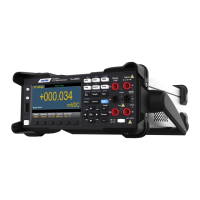86
Configuration: Frequency, 10 V range
1. Configure the measuring frequency under 10 V and 10 kHz, 1 s gated time conditions.
2. A 10 kHz sine wave should be applied between 9 and 11 Vrms.
3. Input the input frequency for the actual application.
The message Calibration Step
Succeeded indicates success.
If the display shows Calibration Step Failed, check
the input value, range, function, and the input calibration value and repeat the
calibration steps.
Capacitance offset calibration (optional)
In general, this calibration is not required. This procedure usually compensates for residual
capacitance offsets that are less than a few pF. In normal use, any residual offset is
overwritten by the null function (the null function also corrects the cable capacitance), and
it is also required to use the null function to implement the capacitance specification of the
multimeter.
Configuration: capacitance
1. Remove all connections from the front terminal of the instrument.
2. Select the front terminal.
3. Enter the calibration value +0.
The message Calibration Step Succeeded
indicates success;
If the display shows Calibration Step Failed, check the input value,
range, function, and the input Calibration value and repeat the Calibration Step.
4. Repeat steps 1 through 3 for the rear terminal of the instrument.
5. Select each range in the order shown in the table below.
6. Apply each input current shown in the Input column.
7. Input the actual input capacitance as the calibration value.
The message Calibration
Step Succeeded indicates success.
If the display shows Calibration Step Failed,
check the input value, range, function, and the input calibration value and repeat the
calibration steps.
8. Repeat steps 5 through 7 for each frequency shown in the table.
The HDM3000 CAP calibration points are as follows:

